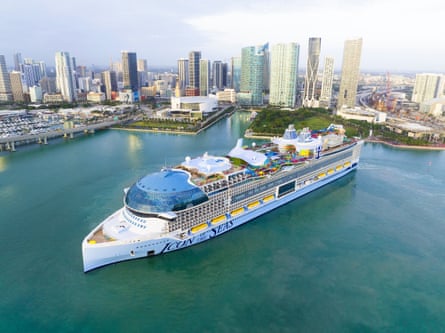Is the world’s largest cruise ship also the most environmentally friendly? The “biggest, baddest” vessel takes to the seas.
The world’s biggest cruise ship, which sets sail from Miami on Saturday for its inaugural commercial trip, was unveiled with much excitement and praise. Standing taller than the Eiffel Tower, the Icon of the Seas boasts 20 decks and can house over 7,000 passengers and crew. Weighing in at a massive 250,000 gross tonnes, it could easily devour five Titanics in one sitting.
Coloured slides on its upper deck mark out “Thrill Island”, the largest waterpark at sea, and it boasts a 17-metre (55ft) indoor waterfall. The president of Royal Caribbean, Jason Liberty, told reporters it was the “biggest, baddest ship on the planet”, though it quickly became known on social media as “human lasagne”.
However, the recent launch of a massive ship in Florida, along with the potential construction of similarly sized or larger ships in the coming years, has brought renewed focus on the environmental impact of cruise tourism.
Several research studies conducted by environmental groups have compared the carbon emissions of a week-long European cruise to that of a flight and hotel stay. The findings showed that these cruises have a carbon footprint eight times higher than the latter.
Royal Caribbean has heavily emphasized that Icon of the Seas is powered by liquified natural gas (LNG), promoting it as the “most environmentally friendly marine fuel”. Nevertheless, Bryan Comer, director of the marine program at the International Council on Clean Transportation, argues that relying on this type of fuel demonstrates a tendency within the industry to invest in ineffective solutions for addressing climate change.
“They are intensifying their stance by promoting LNG as a sustainable fuel, despite the fact that its engine emits 70 to 80% more greenhouse gas emissions per trip compared to traditional marine fuel,” he stated. “Icon’s ship holds the biggest LNG tanks ever installed, but this is simply a form of greenwashing.”
Switching to LNG instead of other fuels reduces carbon dioxide emissions by 25%. However, cruise ships using LNG still produce higher levels of greenhouse gases due to the phenomenon known as “methane slip,” according to Comer. This occurs when some gas is not fully burned, resulting in the release of methane, a much more powerful climate-warming gas than carbon dioxide. Methane has the ability to trap about 80 times more heat in the atmosphere than CO2 within a 20-year period.
According to him, ships ought to utilize fuel cells and sustainable sources of hydrogen or methanol in order to reduce their emission of greenhouse gases.

Display the image in full-screen mode.

Display the image in full screen mode.
Seven years ago, when Icon was created, Nick Rose, a vice-president of Royal Caribbean, stated that LNG was viewed as the most promising readily available fuel.
“We view it as a temporary fuel that enhances the versatility of our ship design and enables us to readily adjust to changing fuel options as the market progresses and new viable alternatives become available.”
The purpose of Icon is to support the use of fuel cells, which generate electricity without burning, for powering the lifts. However, the installation of batteries has been delayed due to supplier issues.
According to Rose, the company is dedicated to discovering and utilizing different forms of energy, such as fuel cells. He stated, “LNG is just one aspect of our plan for alternative fuels, which also includes biofuels, methanol, and other sources like shore power.”
The large vessel has been constructed to utilize shore-provided electricity while docked, in order to reduce reliance on heavily polluting generators. In light of increasing worries about the environment and public health, cities such as Venice, Barcelona, and Amsterdam have implemented restrictions on cruise ships.
According to Marcie Keever, a member of Friends of the Earth US, the cruise industry’s decision to construct megaships and utilize LNG is a step in the wrong direction.
“Expanding ports to accommodate larger ships can have negative consequences on reefs and ecosystems.”
Source: theguardian.com

